|
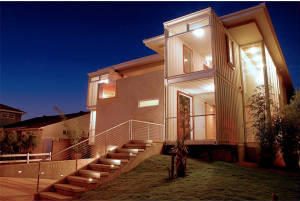
|
| DeMaria Design |
The New Wave:
Shipping Container Homes
By Marc Lallanilla
When Sven and Anna Pirkl were building a house on their lot in Redondo Beach, Calif., they wanted something contemporary,
eco-friendly and interesting. But "contemporary, eco-friendly and interesting" usually comes with a hefty price tag.
Then they met architect Peter DeMaria, who was able to design a cost-conscious house so remarkable that it's already caused two auto accidents due to motorists
crowding the street in front of the home. DeMaria's secret? Shipping containers, those giant steel boxes often seen rusting
on the industrial edges of cities throughout the world.
"The whole idea is that we wanted a simple, modern house," said Sven, who dreamed of loft-style living with an element
of green design. "We were trying to be environmentally friendly while keeping costs down."
But even Sven couldn't anticipate the interest generated by his home made of shipping containers. "We have a ton of people
gawking at it," Sven said of his 3,500 square foot dwelling. "Everyone's curious about the home."
And though some people might balk at living inside a set of shipping containers, fearing they would be dark and cramped,
the sides of the boxes were cut open for doors, windows and interior spaces. "Once you're inside it feels very airy and open
because we have a lot of windows and 10-foot-high ceilings," Sven said.
DeMaria believes that the home would have cost about twice as much to build using standard construction techniques.The
Pirkls were ideal clients, he said, because they were more concerned with creating a comfortable, affordable home than a conventional
one. "They were able to see past all the stereoptypes," DeMaria said, calling his clients "the first people to break on through
to the other side."
Bamboo Flooring: A Green Option?
Get the facts on bamboo flooring,
or get bamboozled
 Is bamboo flooring better than hardwood floors?
There are some advantages to both hardwood
and bamboo flooring options. Hardwood floors like oak and maple come in a variety of colors, widths and finishes; bamboo,
however, is limited to just a few shades, the most widely available being natural (a light blond color), and carbonized (a
medium brown color that's created by heating the bamboo, which makes it slightly softer). Both are durable, attractive and
relatively easy to install.
But bamboo is a much greener option, right?
There is an argument that bamboo flooring
is more sustainable than hardwood flooring. Bamboo reportedly holds more carbon than trees, so it helps to ward off global
climate change. A hardwood oak or maple tree takes many decades to mature; bamboo, on the other hand, is a renewable, fast-growing
grass that quickly regenerates after cutting. It grows so fast, and has become such a popular flooring option, that many acres
of forestland in Asia are reportedly being cut down so locals can grow bamboo.
Cutting down forests to grow bamboo doesn't sound very green.
It isn't, which is why
many people now believe bamboo isn't much of a green product -- call it "greenish." There are also concerns about transporting
the product from overseas, which diminishes its green appeal, and the formaldehyde used in processing most bamboo flooring
is recognized as a cancer-causing compound. Finally, some critics have noted the fast growth of bamboo is sometimes augmented
with synthetic fertilizers and pesticides.

|
| ST Media |
The Facts of Light
Good lighting brightens everything in your shop - including your revenues.
February
2003
By Marc
Lallanilla
Some retailers insist their products look fine under any old light. They are known as auto
parts stores.
But lighting that works for lug nuts and air filters won't necessarily help sell floral
arrangements, where vibrant color and three-dimensional depth are so vital. Like everything else in your retail environment,
your lighting should be designed to do three simple things: attract customers, complete sales and reinforce your store's image.
Understand the Accent Accent lighting that highlights key display areas or
seasonal wall graphics is an easy and inexpensive way to make your store a more interesting place to work and to shop. Halogen
lamps are especially good for accent lighting, as they really punch up the colors of your merchandise.
Keep Your Cool Flowers, as all florists know, need a cool environment for
longevity. Be aware that some types of light fixtures can heat a surface several feet away. You might also get ideas by looking
at how fruits and veggies are lighted at an upscale, boutique grocer (not the corner Quickie-Pickie).
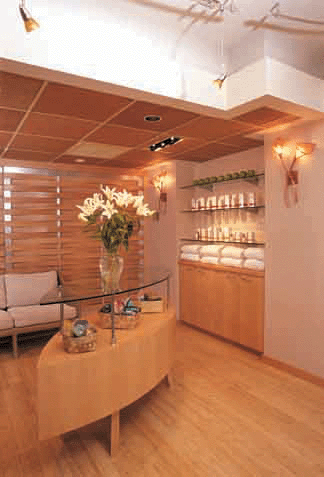
|
| (ST Media Group) |
Form Is Function Lighting fixtures
are not only necessary, they can also be quite beautiful. To light up your sales desk, why not add some beautiful pendant
lights suspended from the ceiling? And light fixtures that are included in a merchandise display, like a small tabletop lamp,
will draw attention to the entire product mix.
What's Watt?
A watt is not measure the light output of a lamp. A watt measures the amount of energy consumed by the lamp. Light output
is measured in lumens. Lumens per watt, or LPW, measures how efficient a lamp is. For energy-saving purposes, most lamps now
list their LPW right on the package.
Balancing Act Lighting designers sometimes speak of balancing the lighting
in a space between overall or ambient lighting, accent lighting, and wall wash lighting. Use a variety of types of lighting
- halogen track lighting here, high-quality fluorescents there - to add interest and dimension to your store.
For more, see Flowers& Magazine
Retirees Create Alternative Communities
More Elderly Americans Are Drawn to Communities That Reflect
Their Particular Interests
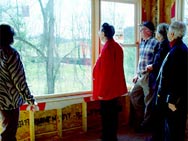
|
| (www.elderspirit.net) |
By MARC LALLANILLA

Oct. 26, 2005 — Like a growing number of retirees, Creigh and Shirley Snyder were not enthralled
with the prospect of spending their golden years in a Florida retirement community.
"We had been to Florida every year for 10 years," said Creigh, 77, a retired sales rep from York, Pa.
"And we decided that we definitely didn't want to live there," added Shirley, 76.
Two years ago, Creigh and Shirley moved to The Village at Penn State, a retirement community affiliated with
Pennsylvania State University, where they found a wide range of activities as well as state-of-the-art health care facilities.
Residents of The Village can enroll in classes at Penn State without paying any additional fees or tuition.
The Snyders are part of a growing wave of retirees who are moving to communities that offer alternatives to
shuffleboard and golf. From developments with a spiritual focus to resorts catering to gays and lesbians, the range of options
for today's retirees is wider than ever.
"Going to golf courses every day isn't an option for everyone," said Jill Lillie, director of community relations
for The Village. She hastened to add, however, "We do have access to Penn State's two golf courses at a reduced rate."
Who Needs Palm Trees?
As baby boomers face retirement, they bring with them the individuality that has defined their generation
— and they're looking for that same individuality in their retirement communities.
"There's no question that the older, traditional versions of retirement have changed, and living arrangements
are part of that," said Elinor Ginzler, director of livable communities for the AARP.
"The trend is diversification — that's what's driving the market these days," said Ginzler. "We all
know the boomers will buy into that completely and they will design it themselves."
So are the palm-studded golf communities of Boca Raton and Scottsdale emptying out? Not anytime soon, notes
Ginzler. "People will still be moving to Sun City," she said.
But sunny weather is no longer the main criterion driving retirees to move. "Climate is not the most important
factor for everyone. People want to live in a community that's significant to them. All of these [communities] are their own
unique niches and none of them dominate over the others."
For the full story, go to ABC News
|
 |
|
|
|
 |
|
Prefab
Housing Goes Fab
Sleek, Modern Designs Spark an Interest
in Prefabricated Houses
By MARC LALLANILLA

April 25, 2006 — Mention the phrase "prefab house"
at a cocktail party, and you'll likely hear jokes about double-wide trailers and mobile-home parks.
But a new wave of architects, designers and home buyers has slowly changed
the image of prefabricated housing by invigorating it with home designs that are elegant, comfortable and spacious.
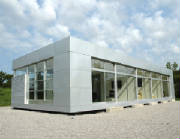
|
| (Rocio Romero) |
Prefabricated housing has reached the upper echelons of the arts community,
too. Recent exhibits at the Walker Art Center in Minneapolis and the Field Museum in Chicago celebrated contemporary prefabricated
housing designs.
And Dwell magazine, the stylish monthly publication that has championed modernist
and prefab design for years, has recently entered into a collaboration with architects and a manufacturer to make the construction
of prefab homes simpler and more affordable.
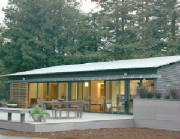
|
| (Michelle Kaufmann Designs) |
From Sears & Roebuck to Sleek and Sexy
The idea of manufacturing a house in a factory and shipping it to a home
site is not new. As early as 1908, companies like Sears, Roebuck and Co. shipped prepackaged kit homes — including lumber,
doorknobs, nails and, yes, the kitchen sink — to more than 100,000 home buyers nationwide.
The Sears program was discontinued in 1940, and in the years following World
War II, prefab construction in the United States consisted of Airstream trailers, geodesic domes and inexpensive, traditional-looking
vacation homes.
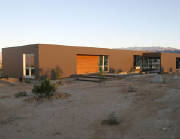
|
| (David Glomb) |
About the same time, a visionary group of architects, including many immigrants
from war-torn Europe, looked anew at residential design. They worked to introduce modern machine technology and materials
like steel and concrete into home construction. Sleek modernist homes with steel framing and broad expanses of glass began
to appear in cities like Los Angeles and Palm Springs, Calif., and Sarasota, Fla.
Although the modernists of the 1950s and 1960s failed to ignite the general
public's imagination, a new generation of consumers has embraced modernist design in all its retro-hip glory. Popular magazines
like Sunset and Dwell now carry the torch for modernist home design.
For the full story, go to ABC News
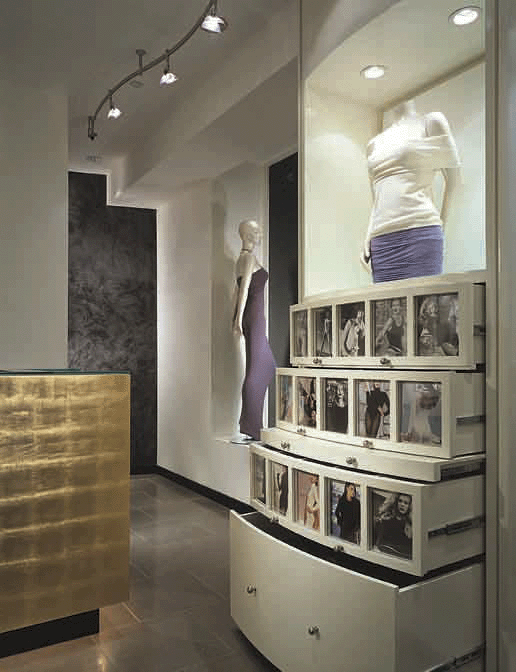
|
| (ST Media Group) |
It's Finished
Eight ideas for approaching the
finishes in your shop's interior.
May 2003
By Marc Lallanilla
Designers are using finishes and
materials in unexpected ways: woven metal for window treatments, bamboo poles on ceilings, even leather on floors. But one
needn't resort to unorthodox treatments to design a retail store that will attract customers, encourage sales and enhance
your business' image.
Low Overhead Most dentist offices have cheap white ceiling tile punctuated by cheap fluorescent lights. They can
get away with it because their customers are anesthetized. Florists without ready access to painkillers may want to consider
the hundreds of other ceiling finishes available -- wood, painted drywall, fabric screens, pressed metal, even colored ceiling
tiles. You may be surprised how different your entire space looks under a different ceiling. Otherwise, crank up the laughing
gas.
Up the Wall Faux techniques like marbling, glazing and sponging were popular about 10 to 20 years ago. Done with
a professional, discriminating eye, the results can look good, but too many weekend projects gone awry have given faux wall
finishes a bad reputation. Ditto for applying faux finishes to furnishings, equipment, accessories, lamps, urns, children,
dogs, etc.
Windows of Opportunity The temptation is everywhere - glamour window treatments. High-quality draperies, blinds
or other treatments can make an interior look great. Other kinds of window treatments, however, can make your shop look all
tarted up like a Vegas showgirl. Save the crushed velvet and shiny silk swags for Halloween, unless you're working out of
a 19th-century Victorian building (or you're Scarlett going to visit Rhett Butler).
Floor Me Hard flooring surfaces like wood, concrete and tile are usually inexpensive and come in a bewildering
range of colors and textures. They're also easy to clean, but in areas where water is likely to spill, beware of slipping
hazards. Choose a hard surface with some texture to it to prevent accidents and those pesky lawsuits.
Combination Plate There are times when a combination of finishes works perfectly. Think of fabric wainscoting
on a painted plaster wall, or tile flooring in high-traffic areas with carpeting elsewhere. But remember: keep it simple,
sweetie.
For more, see Flowers& Magazine
Does LEED Really Work?
LEED certification is expensive, cumbersome,
and more popular than ever
Lots of people -- including architects, engineers, building contractors
and real estate developers -- are asking the same question. Since it was developed by the U.S. Green Building Council (USGBC) over 10 years ago, LEED has come under constant criticism.
Why are people complaining about a program that creates more green
buildings?
Because it actually doesn't create more green buildings, skeptics
argue. What it does, they claim, is create a multimillion-dollar source of revenue for the non-profit USGBC while providing
a great marketing tool for developers. But in reality, many LEED-certified buildings are not all that green -- some, in fact,
are downright brown and use huge amounts of energy.
How can a LEED-certified building be an energy hog?
LEED has gone through several revisions since its inception; the latest
was in 2009. In its early years, LEED certified any building based on a simple point system, and it was much easier to get
a LEED certificate. The point system awarded the same number of points for a simple bike rack as it gave for an advanced heating/cooling
system. Naturally, developers went for the cheaper bike rack, and gamed the system to earn just enough points to win LEED
certification.
Scoundrels! So are any LEED buildings really green or energy-efficient?
Many are, but some aren't. An article in The New York Times reported
that buildings that are designed to be energy- and water-saving turn out to be real resource hogs by the time they're built
and occupied. A lot depends on how the occupants and the maintenance staff use the building -- in that sense, it's a lot like
EPA mileage estimates -- but it also depends on how accurately engineers are able to predict the efficiency of systems
like heating and air-conditioning.
So green buildings should be hot in summer and cold in winter?Not
at all, and the newest LEED standards make allowances for regional priorities. In the past, concerns like water conservation
were given equal weight whether a building was constructed in wet Seattle or dry, hot Phoenix. And buildings located in suburban,
exurban or rural areas -- where access to mass transit is slim to none -- could win LEED certification, despite contributing
to what some critics call "green sprawl" that bulldozes natural ecosystems and forces people into long automobile commutes.
It sounds like this LEED certification is a real crock.Far from it -- despite its limitations, LEED is considered to be a wildly successful
work-in-progress. As of 2009, about 2,000 buildings have been LEED certified, and 15,000 more have applied for certification.
Interest from architects, developers and their clients has been overwhelming. LEED is flexible enough to support everything
from a retail interior renovation, an elementary school, or the development of an entire neighborhood. And the fact that so
many people have complained about LEED is proof that genuine interest in green buildings is here to stay.
What is the USGBC doing to improve LEED?A
lot, and the LEED program gets stronger all the time. The next revision is expected in 2011, and it's predicted that the program
will be revised on a regular 2-year cycle. Third-party LEED certification through the independent Green Building Certification Institute assures that LEED buildings are constructed as intended, according to the USGBC
website. Annual energy use is now monitored following construction and occupancy. And an updated point system that's more
selective and comprehensive will prevent some of the abuses of the past. There are other green building certification programs,
like the EPA's Energy Star and LEED-Plus, as well as international programs, but for now, LEED is a good program that's getting
more robust every year.
|
 |
|
|
|

